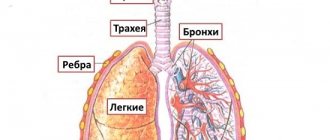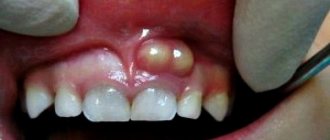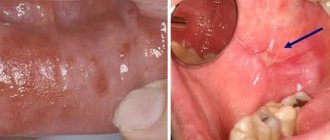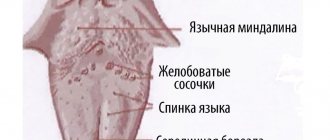Acute tonsillitis is a sore throat that is well known to all of us. The disease is infectious in nature and affects the lymphoid tissue of the palatine tonsils.
The disease occurs at any age, but tonsillitis is more often diagnosed in children.
The palatine tonsils, or the more familiar name “tonsils” to us, are located in the pharynx and are a kind of barrier to infection. Coping with an infection that enters through the mouth, the tonsils remove dead bacteria and viruses from the body and prevent unpleasant diseases from occurring. But if the body’s defenses are not enough, the tonsils cannot cope with the attack, and the pathogenic microflora firmly settles in the tissues of the tonsils, causing inflammation in them.
Why is tonsillitis called acute? Because a sore throat begins suddenly and occurs with severe symptoms.
Most often, acute inflammation of the tonsils is provoked by streptococcus and staphylococcus bacteria, less often the disease is caused by viruses. The following causes of the disease in children are identified:
- past infectious diseases (in this case we are talking about secondary angina);
- the presence of a focus of infection in the child’s oral cavity and nasopharynx (stomatitis, caries, sinusitis, etc.);
- impaired breathing through the nose due to hypertrophied adenoid vegetations or formed polyps;
- anatomical features of the pharynx;
- allergy;
- hypothermia;
- low immunity.
Sore throat is a highly contagious disease. It spreads by airborne droplets or contact. The development of the disease in a child often begins after close communication with other children. After all, the child is constantly in a group, be it a kindergarten, school or section. Therefore, it is not surprising that the diagnosis of “acute tonsillitis” is often present in the anamnesis of young patients.
During a disease epidemic in a child’s preschool or school, if possible, it is better to stay at home.
Symptoms of tonsillitis in children
The first symptoms of the disease appear suddenly. The child complains of a sharp sore throat. This makes it difficult for him to swallow. There is a lump in the throat. The patient refuses to eat. In this case, enlarged lymph nodes in the neck can be clearly felt.
In acute tonsillitis, body temperature rises sharply to 39-40℃. As the disease progresses, symptoms of intoxication become more and more apparent: nausea, vomiting, headaches, dizziness. Possible unpleasant reactions from the gastrointestinal tract.
Another characteristic symptom of angina is the appearance of a white or yellowish coating on the tonsils. It may differ depending on the type of sore throat (for example, in the form of a white film or pustules).
Make an appointment right now!
Call us by phone or use the feedback form
Sign up
When a child is ill, he does not feel like eating, he quickly gets tired, weak and drowsy.
If you start treating the disease on time, the symptoms of inflammation gradually disappear and recovery occurs.
If treatment is delayed or the acute form of the disease was initially treated incorrectly, without consulting a doctor, the course of a sore throat may be aggravated by severe complications.
Sore throat: main complications
Everyone has probably encountered tonsillitis, or, as it is also called, acute tonsillitis. Some heard about the disease from a friend, while others themselves felt the characteristic symptoms - high fever with chills, severe weakness and a sharp pain in the throat when swallowing. What is a sore throat and why is it so dangerous?
Angina and its treatment
Acute tonsillitis is an infectious disease that can be caused by various types of pathological microorganisms, but most often the causative agent of sore throat is beta-hemolytic streptococcus.
Once upon a time, sore throat was considered a fairly serious disease, which in some cases could even lead to death, but the situation has changed radically since the discovery of antibiotics. Nowadays, sore throat responds well to treatment with antibacterial drugs, provided that the medicine is correctly selected and the treatment regimen is followed.
Forms of sore throat in children
Children have all types of tonsillitis that adults suffer from. It all depends on the age of the child. In children under 3 years of age, sore throat most often develops due to a herpetic infection. In children from 3 to 7 years old, sore throat is most often caused by bacterial flora (but the proportion of streptococcal infection is small), in school and adolescence it is also bacterial (in half of the cases it is caused by streptococcus).
Sore throats are divided into:
- primary - inflammation immediately begins in the tonsils (tonsils);
- secondary - sore throat occurs against the background of other infectious diseases (scarlet fever, diphtheria, measles, etc.);
- specific - when the palatine tonsils are affected by specific microflora (fungi, chlamydia, etc.).
Based on the nature of the changes occurring in the tonsils, the following forms of angina are distinguished:
- Catarrhal is the mildest type of disease, which affects only the surface of the tonsils. The inflammatory process is indicated by enlargement and redness of the glands. If the disease is not treated, within 3-5 days catarrhal tonsillitis changes to another form.
- Follicular - pustules appear on the surface of the palatine tonsils - purulent follicles. The patient feels better when these pustules open. Recovery occurs in approximately a week.
- Lacunar tonsillitis is similar in symptoms to follicular tonsillitis, but is more severe. Purulent plaque appears in the lacunae of the tonsils. This form of sore throat is easily confused with diphtheria. The disease lasts about a week, but if not properly treated it can lead to complications.
- Phlegmonous tonsillitis is a fairly rare but severe form of tonsillitis, in which a purulent abscess forms on one side. The abscess must be opened. After this, the patient feels better. Phlegmonous tonsillitis often occurs as a complication of the follicular and lacunar forms.
- Necrotizing tonsillitis - a gray coating forms on the tonsils. When the plaque is rejected, bleeding ulcers form in its place. This is a severe form of sore throat.
According to the severity of the course, angina is classified into mild, moderate and severe. With a mild form of sore throat, the temperature does not exceed 38°C and lasts up to 5 days. There is soreness in the throat and a slight enlargement of the lymph nodes. But there is no strong weakness.
With a moderate angina, the temperature reaches 38.5°C. There is a feeling of weakness, aching in the muscles and joints. Lymph nodes are enlarged. Symptoms last up to 8 days. A purulent coating is noticeable on the tonsils, which disappears within a week. There are no complications.
Severe sore throats occur with pronounced symptoms of intoxication: a temperature of 40°C that lasts for more than a week, vomiting, diarrhea, and abdominal pain. There is a coating on the tonsils that does not disappear for more than a week. Lymph nodes are painful and greatly enlarged. Convulsions are possible.
Based on the presence of complications, angina can be either without complications or with complications.
Sore throat (acute tonsillitis)
Symptoms
The leading symptom is a sore throat, especially when swallowing and eating. The intensity of the pain syndrome can vary from quite tolerable to severe. The severity of symptoms of general intoxication (increase in body temperature from 37°C to 40°C or more, weakness, general malaise, headache, loss of appetite, sleep disturbances, enlarged and painful regional lymph nodes) and local inflammation in the tonsils also varies in different cases ( swelling, hyperemia).
The most typical, common manifestations of acute tonsillitis are listed above. Other symptoms may differ so significantly that this serves as the basis for identifying several relatively independent clinical forms.
Catarrhal sore throat is the most common and, fortunately, the least severe form. It manifests itself as a burning sensation, a “soreness” in the throat, drying out of the mucous membranes of the oropharynx, a coated tongue, and moderate pain when swallowing. As a rule, the syndrome of infectious intoxication occurring against the background of low-grade fever has an asthenic component. A mucopurulent coating may appear on the tonsils. With a sufficient immune response, symptoms are reduced within a few days.
Follicular tonsillitis , also very common, usually manifests itself with high fever, sharp radiating pain in the throat, severe clinical intoxication, a feverish state (up to symptoms of depression of the central nervous system), gastrointestinal disorders, and vomiting. Multiple suppuration of small follicles gives the tonsils a characteristic “starry sky” appearance; spontaneous opening leads to accumulations of pus. The active phase of the disease lasts about a week.
Lacunar tonsillitis is, in fact, a more severe version of follicular tonsillitis. Muscle and joint pain and cardialgia are often added. Tonsils, as a rule, are covered with purulent plaque in the form of films.
Fibrinous tonsillitis , in turn, can be considered as the next phase in the development of lacunar tonsillitis: a continuous yellow-white coating forms, covering not only the tonsils, but also adjacent areas.
Phlegmonous tonsillitis is characterized by a widespread, diffuse purulent-inflammatory process in the parenchyma of the tonsil (usually one of the two). The muscles of the temporomandibular joint often spasm. The current is severe.
Gangrenous tonsillitis (Vincent's ulcerative-necrotizing tonsillitis, see above) is characterized by massive death of cells in the affected tonsil, putrid breath, deep ulceration with the formation of defects due to purulent melting of the tissue. Body temperature in most cases remains moderately elevated or normal.
Herpetic (viral) tonsillitis occurs more often in children, is distinguished by a particularly acute onset and high contagiousness, polymorphic severe symptoms (including from the gastrointestinal tract), which, however, are quickly reduced. The tonsils are covered with small red, inflamed blisters.
As is often the case in medical practice, the prevalence and fame of the disease does not at all guarantee against severe complications. The dynamics of acute tonsillitis can result in an intra- or peritonsillar abscess, trigger the start of a rheumatic process, glomerulonephritis; the rapid spread of infection in some cases results in meningitis or secondary inflammation of another localization, as well as life-threatening infectious-toxic shock or sepsis.
Possible consequences of sore throat in children
Angina is one of those diagnoses that, with adequate and timely treatment, have a favorable prognosis for recovery. But if the treatment was incorrect, it is possible that complications will develop, which may appear immediately during the course of acute tonsillitis, or may become delayed and appear after recovery. Complications are also divided into local, which negatively affect the pharynx, and general, which affect other organs and systems of the body.
Local consequences of sore throat in children include:
- purulent lymphadenitis - inflammation of the lymph nodes that occurs with the formation of purulent accumulations, the disease is treated surgically;
- swelling of the larynx - the greater the swelling, the higher the risk of suffocation;
- otitis - the nasopharynx is connected to the ear through the auditory (Eustachian) tube, through which the infection easily penetrates into the middle part of the ear during coughing or sharp blowing of the nose, triggering an inflammatory process in it;
- peritonsillar abscess - a condition in which the cavity located in the tissues around the tonsils fills with pus;
- bleeding from the tonsils;
- the likelihood of transition to the chronic form of acute tonsillitis, that is, the development of chronic tonsillitis, when the symptoms of the disease will return throughout the year, subsiding only during remission.
Common complications include heart, kidney, and joint complications.
Friends! Timely and correct treatment will ensure you a speedy recovery!
All these dangers can certainly be avoided if the disease is diagnosed and treated in a timely manner.
Symptoms
Symptoms of stomatitis appear depending on the cause. In any case, the first signs are itching and redness of the affected area, the tongue feels uneven. Further, the manifestations are already different from each other.
- Virus - itching intensifies, redness spreads to new areas, rash.
- Bacterial nature - first a rash, then vesicular formations, then blisters, ulcers that become inflamed and or fester.
- Fungi - from the very beginning, a white coating and unbearable itching, accompanied by an unpleasant, sometimes putrid odor from the mouth.
- Increased sugar - the formation of wounds with the release of colorless liquid (ichor), a constant sweetish odor is emitted from the mouth.
- Allergies - a small rash with or without itching, headache, possible weakness, nausea, unfocused attention for a few seconds.
- A sharp increase in temperature to 39 and above, regardless of the time of day, the temperature is not brought down by antipyretics. The skin peels off.
- Immune diseases - the temperature does not rise or drops to 36 and below, weakness, nausea, short-term fainting is possible.
Important! If the symptoms of stomatitis last 5-7 days or longer and no treatment is carried out, the disease goes into an advanced form with possible complications in the form of periodontitis, ulcers in the oral cavity, the development of connective tissue cancer, meningitis, breakthrough of suppuration into the lymphatic system or entry into the blood vessels , and this is blood poisoning, which, if not treated promptly, can be fatal.
Diagnostics
A consultation with an otorhinolaryngologist begins with collecting the patient’s medical history and complaints. The ENT doctor finds out how long the symptoms of inflammation have been appearing and whether any treatment has already been carried out. Direct examination includes palpation of the neck, parotid and occipital areas. Then the ENT doctor examines the oral cavity and pharynx. If necessary, an endoscopic examination of the pharynx is performed. He assesses the condition of the mucous membranes, palatine tonsils (their size, the presence of plaque on them or purulent plugs in them).
The patient may also be prescribed laboratory tests: a general blood test, a throat smear. If complications are suspected, serological blood tests, X-rays, electrocardiography, etc. are additionally performed.
After suffering a sore throat, a child may be diagnosed with myocarditis, arrhythmia, heart murmurs, pyelonephritis, renal failure, and rheumatism. If an infection from the tonsils enters the bloodstream and spreads throughout the body, sepsis may develop.
Is stomatitis transmitted?
Allergic stomatitis
– one of the most common and intractable types of the disease.
The cause is an allergy, but what exactly is allergy is to be determined first. Allergens can be both food and medicine, as well as materials for dentures installed in the oral cavity. The typical course of stomatitis - the occurrence of painful ulcers - can be further complicated by difficulty breathing and swallowing, typical of allergies. Allergic stomatitis is not transmitted
except through hereditary means.
Viral (herpetic) stomatitis
- another popular type of this disease, especially common in small, close groups of people (schools, kindergartens, work groups, camps).
Its cause is the herpes virus, and its features are erosive spread (others may appear next to one ulcer) and the possibility of severe complications with fever, nausea, vomiting and diarrhea. This is the most contagious variety; in 80% of cases, this stomatitis is transmitted both by airborne droplets and by contact
.
Aphthous stomatitis
– most often occurs in adults, and is associated with weakened immunity.
That is why outbreaks of aphthous stomatitis occur mainly in spring and autumn. It is characterized by the formation of aphthae - small ulcers, both single and occurring in clusters. This stomatitis is not contagious
and cannot be passed on to other people.
Fungal stomatitis (candidomycosis)
– is characteristic of both children (mainly infants) and adults, and mainly women.
It occurs due to Candida fungi, which multiply in the mouth due to weakened immunity or long-term use of antibiotics. It is characterized, in addition to the formation of ulcers, by a white “curdled” coating on the tongue, palate and inner surface of the cheeks. This stomatitis is contagious
: it can be transmitted through direct contact or through household and hygiene items (towel, toothbrush, dishes). A pathogenic fungus can remain in the body for some time and develop in an environment favorable to it.
Nicotine stomatitis
– as the name suggests, occurs in smokers as a result of a long-term addiction to cigarettes.
Tobacco smoke, affecting the oral cavity, actively promotes the growth of bacteria, and also irritates the palate, the tissues become denser, resulting in the formation of numerous ulcers. This type of disease is especially dangerous: although it is not transmitted to other people
, and generally goes unnoticed for a long time, it can develop into oral cancer.
Acute tonsillitis: treatment of sore throat in children
Therapy for chronic tonsillitis includes medications and physiotherapeutic procedures. The following are prescribed as drug therapy:
- antibiotics;
- antipyretic drugs;
- antiseptic solutions for gargling;
- antiseptic sprays for treating tonsils and pharyngeal mucosa;
- tablets and lozenges for sore throat.
It is very important for the patient to adhere to a diet, excluding too hot or cold liquids, spicy or solid foods. If the child has no appetite, do not insist, but more often give him warm tea, fruit drinks or compotes. The patient's room must be frequently ventilated and wet cleaned.
Traditional medicine recipes should be used with caution, after consulting with your ENT doctor.
Firstly, they can provoke an allergic reaction, and secondly, traditional medicine should not be used as the only method of treatment - only as an additional method. When treating a sore throat in children, you can gargle with herbal decoctions (chamomile, sage), consume honey and other bee products.
If you follow all the recommendations of the otorhinolaryngologist, the symptoms gradually subside, and the baby is on the mend.











